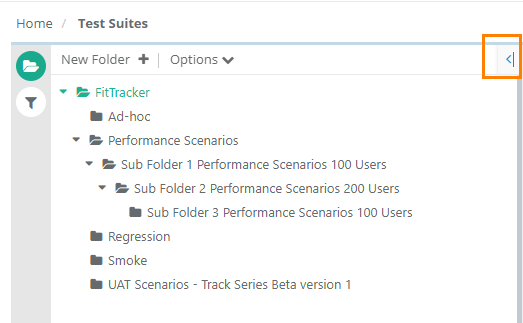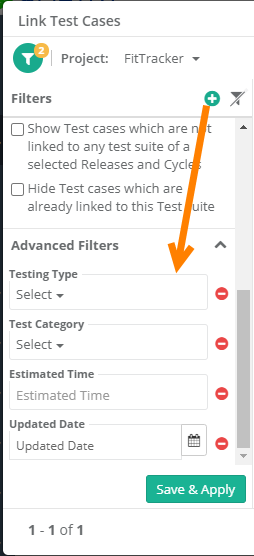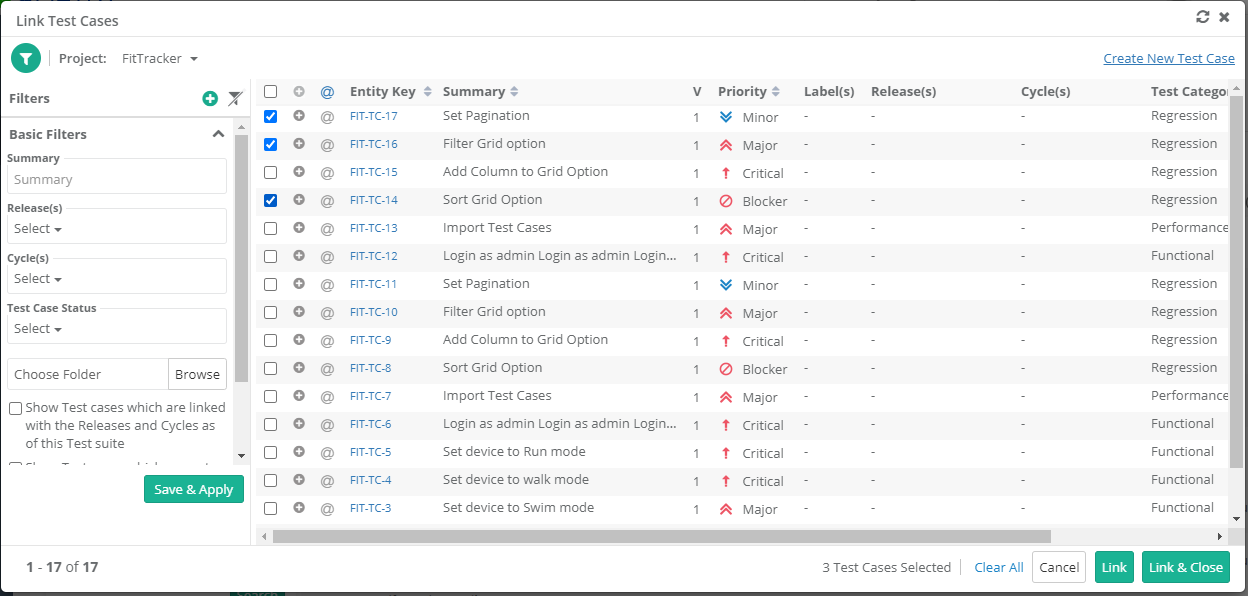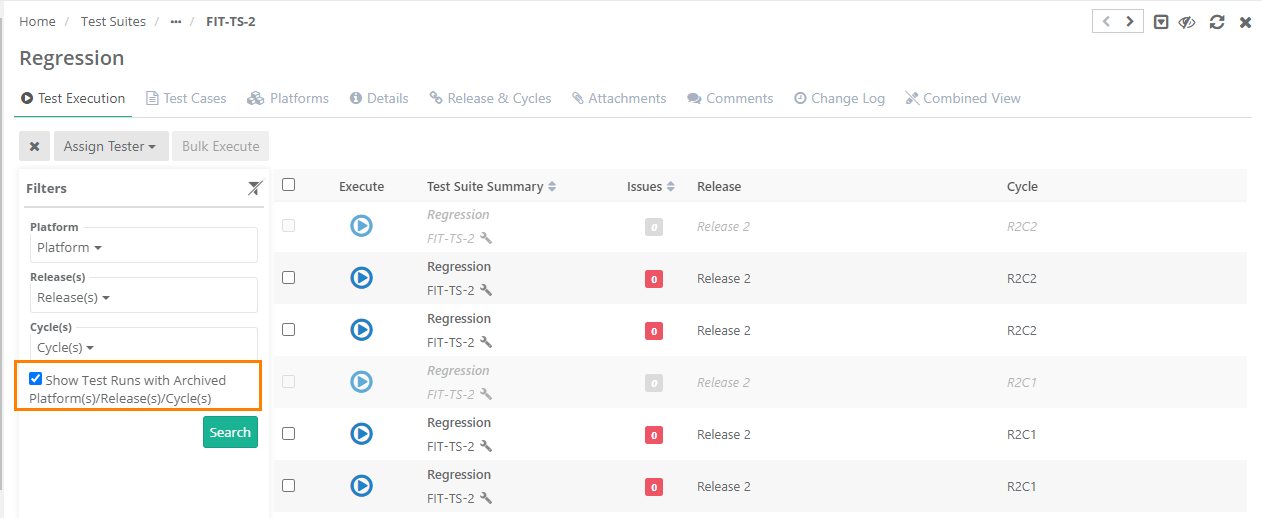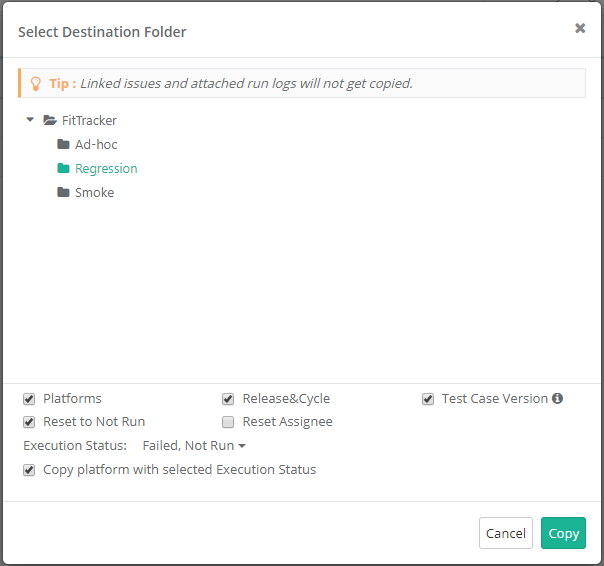| Table of Contents | ||
|---|---|---|
|
...
Adding a Test Suite Folder
The tree/folder panel is expandable that facilitates stretching of the area if you want to view longer folder names. You can also hover over the folder to view its full name.
On the Test Suite tree, click on the New Folder button to add a new folder.
...
If you try to save a test suite without linking a Platform to it, then the confirmation message shows up.
The Platforms tab on the test suite details page displays linked platforms.
To view archived platforms, select the Show Archived filter on the Filters pane.
Linking Test Cases with Test Suite
...
- Click on Link Test Cases from Requirement button.
- A pop-up window with list of Requirements opens. The window displays only those requirements which have test cases associated with them.
- Filter the requirements based on your scope of testing. Use filter option based on Summary, Version Id, Priority, Labels, Releases, Cycles, Created By, and Folder path.
- Select the requirements.
- Click on the Link Selected Requirement button.
- Test Cases associated with the selected requirements will be linked to the test suite.
...
Select the field you want to apply filter on. The filter parameter is added as Advanced Filters. Apply filter as per your requirement.
Users can link test cases from other projects as well. The Project drop-down is provided to select the project. The test cases for the project are displayed on the screen.
- Select test cases that you want link to the test suite. The Filters will populate only for the selected Project. Additional filters Labels and Folder path are added for the ease of searching.
- You can select a particular Version of the test case to link to the test suite. Test Cases with multiple versions are expandable.
...
Select the test cases you want to link with the test suite and then click on the Link Selected Test Cases button at the bottom.
You can also link individual test cases by clicking on the link icon for respective test cases.
The test case(s) are linked to the test suite.
...
If test cases from other project are linked, then the test cases show Entity Key of the corresponding project.
...
- B. Bulk Execute: Status can be updated in bulk for multiple test cases and their platforms.
View Archived Test Runs
An execution/test run is archived when either Platform/Release/Cycle is archived. When a platform or Release/Cycle is archived, the test executions having such platform/release/cycles associated with them will be hidden on the Test Executions tab of the test suite.
The Show Test Runs with Archived Platform(s)/Release(s)/Cycle(s) check box is provided on the Test Executions tab. To view the test runs which are archived either due to platforms/release/cycles, select the check box in the filter.
While import any change in the status of such archived test case executions will be ignored.
Bulk Execute
The feature allows assigning Execution Status, Execution Type and Assignee in bulk. It is useful when users have to execute a test suite which has multiple test cases, multiple associated platforms and multiple releases & cycles associated with it. Once triggered, the processes to assign Execution Status, Execution Type and Assignee to the selected test case(s), release(s) & cycle(s) and platform(s) are run in background.
...
The following is the screen to select folder and other options to copy test suite.
Select a folder on the tree in which the test suite is to be copied.
The check boxes - Platforms, Release & Cycle and Reset to Not Run are selected by default.
- Platform: Select the check box to copy the associated platform with the test suite that is being copied. This option is selected by default; however, some companies who change platforms frequently between releases may opt to deselect this from time to time to avoid adding a lot of test runs with platforms that are not needed for testing.
Use Case: A QA manager of a mobile app company needs to copy the regression suite from the last release to the new test cycle; however, they do not want to copy platforms because the mobile devices they needed to test against have changed.
- Release & Cycle: Select the check box to copy Release & Cycle associated with the test suite. This option is selected by default. If you do not want to copy the releases and cycles associated with the test suite, then deselect this option.
- Test Case Version: It will sync test cases with the latest unarchived version of the test case that is associated with the test suite. This allows users to easily create regression suites using latest unarchived version of test cases. If you want to use the preserved version of the test case then deselect this option.
- Reset to Not Run: Select the check box to reset the test case execution status to Not Run.
- Reset Assignee: Select the check box to reset the Assignee.
- Execution Status: On the Execution Status drop-down, select the Execution Status of test cases you prefer to copy the test cases of.
- Copy platform with selected Execution Status: Users can copy Platforms based on selected Execution Status above. Only those platform will be copied which has test case with selected execution status. The check box is enabled on selecting the Execution Status. Select the check box to copy platforms which has test cases with selected status run.
Use Case: While copying a test suite, testers want to copy only "Failed" test cases, and only the Platforms that have the failed test cases, so that while testing in a new sprint, they test only the failed test cases, on the platforms on which they have failed. They do not need other platforms to be copied.
The following matrix shows the impact of option selected on the screen.
...
